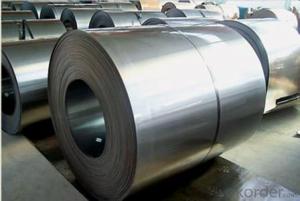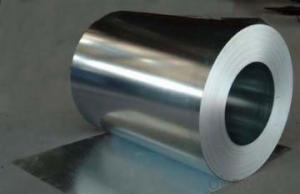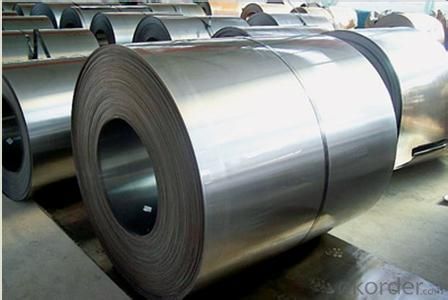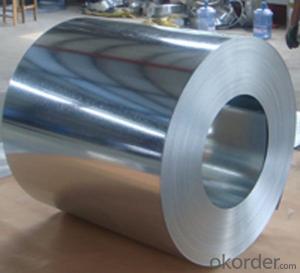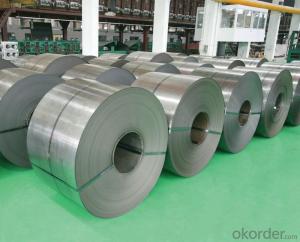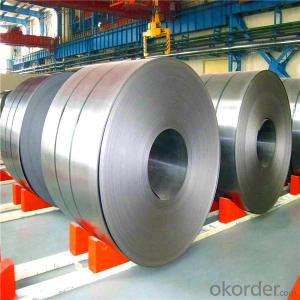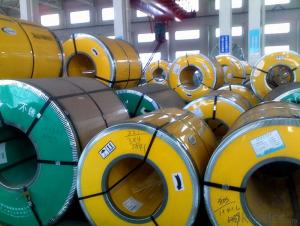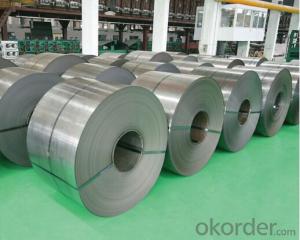Cold Rolled Steel Coil with Prime Quality
- Loading Port:
- Shanghai
- Payment Terms:
- TT OR LC
- Min Order Qty:
- 100 m.t.
- Supply Capability:
- 10000 m.t./month
OKorder Service Pledge
OKorder Financial Service
You Might Also Like
1.Structure of Cold Rolled Steel Description:
The raw material of cold rolled steel coil/sheet is high quality hot rolled product, and after pickling continuous rolling, degreasing, annealing,skin pass,slitting and cut to length line etc. Along with it many kinds of new technology and new process of global cold rolling production have been applied. Therefore the quality of the goods could be guaranteed. 2.Main Features of the Cold Rolled Steel:
• Excellent process capability
• High strength
• Good formability
• Good visual effect
• Smooth and flat surface
• Workability, durability
• Excellent heat resistance performance
3.Cold Rolled Steel Images

4.Cold Rolled Steel Specification
Standard:AISI,ASTM,DIN,GB,JIS,JIS G3302 ASTM 653M EN10142
Width: 1250,600-1250mm
Coil weight:3-12 MT
Coil ID:508/610mm
Grade: Q195~Q345
Thickness: 0.16mm~1.5mm,0.16-1.5mm
Chemical composition:
C | Si | Mn | Cr | Ni | P | S |
0.150 | 0.476 | 11.231 | 12.50 | 0.900 | 0.039 | 0.010
|
5.FAQ of Cold Rolled Steel
We have organized several common questions for our clients,may help you sincerely:
1.How about your company?
A world class manufacturer & supplier of castings forging in carbon steel and alloy steel,is one of the large-scale professional investment casting production bases in China,consisting of both casting foundry forging and machining factory. Annually more than 8000 tons Precision casting and forging parts are exported to markets in Europe,America and Japan. OEM casting and forging service available according to customer’s requirements.
2.How to guarantee the quality of the products?
We have established the international advanced quality management system,every link from raw material to final product we have strict quality test;We resolutely put an end to unqualified products flowing into the market. At the same time, we will provide necessary follow-up service assurance.
- Q: I need to know where to go online to buy a steel cage for a wrestling ring.. Somebody please assist me?
- Steel cages are made from scrap. From either loose metal or loose chains. There might be some on eBay that would be man-made
- Q: How are steel coils used in the manufacturing of metalworking tools?
- Steel coils are used in the manufacturing of metalworking tools by being formed and shaped into various components such as blades, cutting edges, and handles. These coils serve as the primary raw material, which is then processed and treated to create durable and high-quality tools that can withstand the rigors of metalworking processes.
- Q: What are the common surface defects found in steel coils?
- There are several common surface defects that can be found in steel coils. One of the most common defects is rust or corrosion. This occurs when moisture comes into contact with the steel surface, causing it to oxidize and form rust. Another common defect is scratches or abrasions, which can occur during the handling or transportation of the coils. These can range from minor surface scratches to deeper gouges that can affect the structural integrity of the steel. In addition, there can be surface roughness or unevenness, which can be caused by improper rolling or cooling processes during manufacturing. This can result in an inconsistent surface texture that may impact the appearance and performance of the steel. Another defect is scale, which is a layer of oxide that forms on the surface of the steel during the manufacturing process. This can give the steel a rough and uneven appearance. Finally, there can be oil or grease stains on the surface of the steel, which can occur during the manufacturing or handling process. These stains can affect the adhesion of paints or coatings applied to the steel. Overall, these common surface defects in steel coils can impact the quality, appearance, and performance of the steel, and may require remedial actions such as cleaning, grinding, or recoating to resolve.
- Q: What are the different types of steel surface finishes for coils?
- There are several types of steel surface finishes for coils, including hot rolled, cold rolled, galvanized, and coated finishes. Each finish offers unique properties and characteristics, such as improved strength, corrosion resistance, or aesthetic appeal. The choice of finish depends on the specific application and desired outcome for the steel coils.
- Q: and which one is better?i'm looking into buying some aftermarket headers, but companies make them in both chrome and stainless steel
- I know nothing of aftermarket headers so can't help you there, but - chrome is a coating on metal. Stainless Steel is a type of metal.
- Q: What are the key factors affecting the strength of a steel coil?
- The key factors affecting the strength of a steel coil are the composition of the steel, the heat treatment process, the rolling and cooling processes, and the presence of any impurities or defects in the coil.
- Q: What are the quality standards for steel coil production?
- The quality standards for steel coil production typically include factors such as dimensional accuracy, surface finish, mechanical properties, chemical composition, and adherence to industry-specific standards and specifications. These standards ensure that the steel coils meet the required strength, durability, and performance criteria, and are suitable for various applications in industries like automotive, construction, and manufacturing.
- Q: i currently have just steel guitar strings, not a fan they need replacing and i was wondering whats the difference between steel and bronze strings and or nickle strings?
- You may want to experiment with different alloys to find which sound best on your guitar...but if it's acoustic, you should be using bronze wound strings.
- Q: What are the common applications of galvanized steel coils?
- Galvanized steel coils are commonly used in a variety of applications, including construction, automotive manufacturing, electrical appliances, and agricultural equipment. They are particularly useful for roofing and siding materials, as well as for creating durable and corrosion-resistant components in various industries.
- Q: How are steel coils inspected for weldability?
- A series of comprehensive tests and examinations are carried out to inspect the weldability of steel coils. The main objective of this inspection is to assess the quality and suitability of the steel coils for welding purposes. To begin with, a visual inspection is conducted to identify any visual defects or irregularities present on the surface of the coils. This includes checking for factors such as surface roughness, cracks, scratches, or any other imperfections that might affect the weldability. Following this, destructive testing methods, such as tensile testing and impact testing, are performed. Tensile testing measures the strength and ductility of the steel, ensuring that it meets the required mechanical properties for welding. Impact testing evaluates the steel's ability to resist brittle fracture, which is crucial in determining its weldability. In addition, non-destructive testing techniques like ultrasonic testing (UT) and magnetic particle inspection (MPI) are employed to detect any internal defects or discontinuities. UT utilizes high-frequency sound waves to identify hidden flaws within the steel, while MPI uses magnetic particles to identify defects on or near the surface. Moreover, chemical analysis is carried out to determine the composition of the steel and ensure that it meets the required specifications for welding. This analysis involves checking the levels of carbon, manganese, sulfur, and other elements that may impact the weldability and overall performance of the steel. Furthermore, weldability testing is performed to evaluate how the steel responds to welding processes. This involves conducting various welding trials using different techniques and parameters to assess the steel's behavior during welding, including its susceptibility to cracking, distortion, or other welding-related issues. In conclusion, the inspection of steel coils for weldability is a comprehensive process that involves visual inspection, destructive testing, non-destructive testing, chemical analysis, and weldability testing. Through these thorough inspections, manufacturers can ensure that the steel coils meet the required standards and are suitable for welding applications.
Send your message to us
Cold Rolled Steel Coil with Prime Quality
- Loading Port:
- Shanghai
- Payment Terms:
- TT OR LC
- Min Order Qty:
- 100 m.t.
- Supply Capability:
- 10000 m.t./month
OKorder Service Pledge
OKorder Financial Service
Similar products
Hot products
Hot Searches
Related keywords
